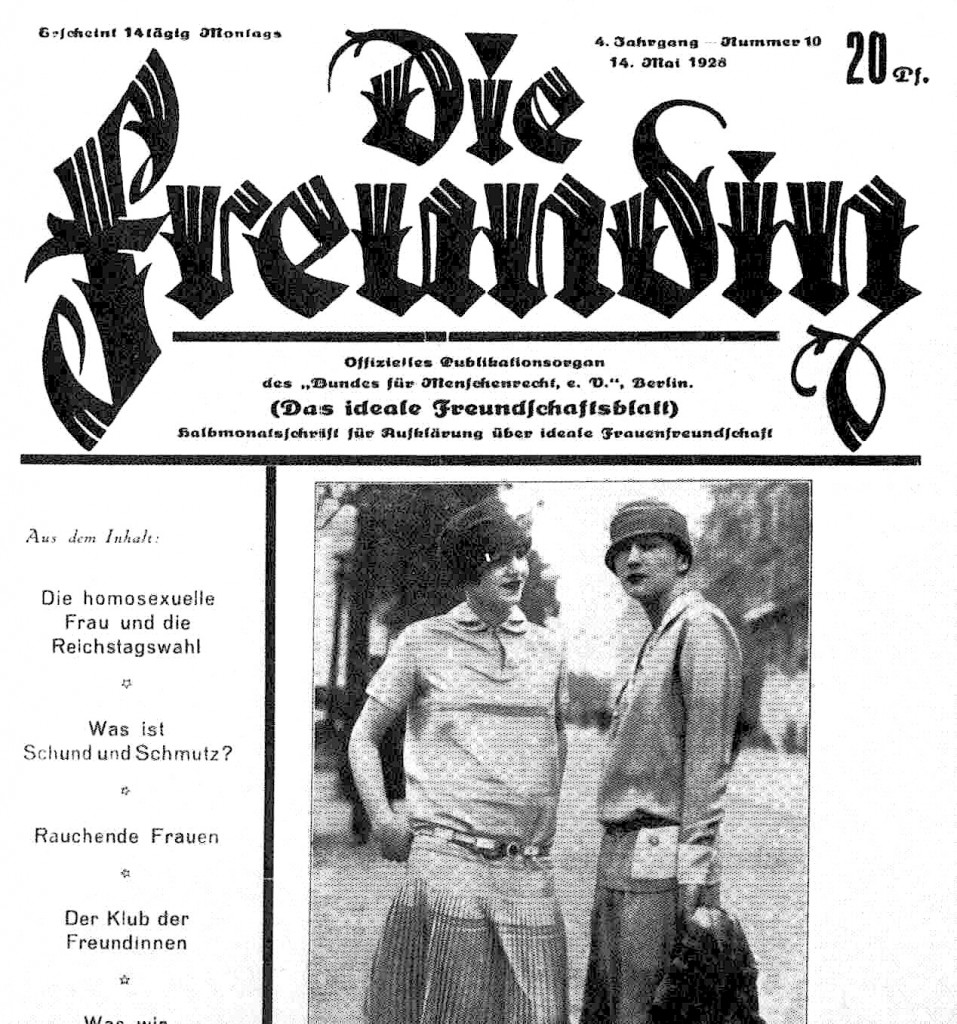
“Die Freundin,” a magazine geared towards queer women in pre-WWII Berlin
I wanted to approach this—my first Queer Berlin column—with the same vigor and vitality that I experience in Europe’s artistic hub, capturing an arguable third-wave queer zeitgeist with an imagined lavender typewriter and a healthy dose of post-twenties skepticism.
By the time this is published, I will have entered my thirties, a weighty fact that allows me to designate epochs like the following:
The first wave of Berlin queer migration might be titled the Christopher Isherwood Epoch, a Weimar romance retold and immortalized by a million Cabaret knock-offs, with the Kit Kat club as its dragged/drugged-out, velvety backdrop.
I think it’s particularly revealing that 1920s Berlin even had its own lesbian magazine called Die Freundin.
The second wave could be called the Bowie Times, an age rekindling West Berlin’s utopian sense of transgression and personal freedom, recently made nostalgic in David Bowie’s song and Tony Oursler’s video “Where Are We Now?”
If you visit Berlin, you can literally retrace the White Duke’s famously light tread with the Bowie Walk.
And then we have now, an as yet unnamed third wave of voluntary expatriation characterized in part by financial escapism, with Berlin luring disillusioned youth with its not-totally-incorrect image as a progressive metropolis with a medieval sense of money: a barter economy dealing in creative ambition, trading homemade corsets for old Ramones buttons.
Which brings me surprisingly to James Franco, an artist whose herculean cross-disciplinary artistic efforts conjure a kind of zeitgeist all their own. His new exhibition Gay Town at Peres Projects, his second at the gallery, is at least superficially gay. The show revels in shallowness and slick transformations, portraits of Harvey Milk, and casual allusions to gay sex, perhaps a precursor to his remake of the ’70s classic Cruising. All of this reveals a shockingly flip attitude towards contemporary queerness and very little about Franco himself.
In an interview with Vernissage TV, gallerist Javier Peres explains that the entire show is “very much like a self-portrait,” with most of the work included made in temporary studios while on location. A lot of the works included in Gay Town refer to on-set antics like his “bromance” with Seth Rogen, or his presumed relationship with Pretty Little Liars star Ashley Benson. There is a whole antagonistic Fuck Spiderman series, and a painting of the Wizard of Oz witch labeled “Mila Kunis.” I hope there’s more to it than I assume.
James Franco, “Fuck Spiderman 1,” 2012. Courtesy Peres Projects.
Walking past fat animal paintings, and a number of works with the scrawled byline “boobs,” I began shaking my head and muttering to myself like a profoundly disappointed high school teacher who has to read 30 plagiarized summaries of the Heart of Darkness. A painting of Franco on his high school water polo team? Spring Breakers? It’s clear that Franco wants to peel away some Hollywood gloss and leading man mystique, but he lacks any of the self-deprecating finesse required for such a gesture. One the other hand, a gritty video of himself engaged in some of the acts he alludes to? Now that would be something.
James Franco, “Gay Town” installed at Peres Projects, 2013.
The show has a scatter-art feeling, with carpets hung in every corner and propped-up white structures housing video installations, neon signs, and cryptic, child-like texts. It reminded me of Larry Clark‘s montage from 1993, now at the New Museum in New York, a dated contribution that seems better suited for an indie video rental store-slash-head shop.
Perhaps channeling his juvenile energy, the notes from my outing read like a 16-year-old boy’s exercise in Dadaism: “Gucci boobs, heavy-metal, milk, gayness = coolness, 127 existential hours, rugs, deer-humping, vampires n’ shit.”
The show is maddeningly egocentric and self-congratulatory, but I think it’s worth writing about because it opens up debates about ownership, responsibility, and queerness as aesthetic. Franco flaunts his support of gay rights like a token of authenticity for a new-century-sensitive-man. Perhaps Franco doesn’t realize that the average Berlin art viewer is accustomed to explicitly queer subject matter (Wolfgang Tillmans and Nan Goldin, among others, have had major museum survey exhibitions in Berlin over the last few years). Seeing Franco recite prose in drag doesn’t induce much of anything except a shrug and perhaps a maternal eyeroll.
————————————–
“Queer Berlin” is a new bi-monthly column surveying Germany’s queer arts culture, as well as that of the artist-émigrés who seek asylum in Berlin’s old-world arms. Written by Ali Fitzgerald, who previously contributed to our column “Lives and Works in Berlin,” she says: “If Berlin were personified, it probably wouldn’t be straight. A constant negotiation of Weimar-era traditions generates a myriad of queer potentialities rooted in politics, performance, and transgression. From state-supported museum surveys to queer operas and activist interventions in cellars and basement breweries, ‘Queer Berlin’ investigates the mythos of Berlin as a progressive queer state, as well as the real-world demands of a rapidly expanding queer community.” Check back in April for her next post.